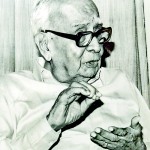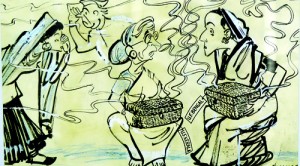Sketching out a wider audience for political cartoons
A newspaper cartoon is a powerful communicator – an illustration drawn to represent a current event or a personality in a satirical but

photograph of the cartoonist
comprehensible manner, it can depict complex ideas and convey a larger meaning. As the old saying goes, “a picture is worth a thousand words.” A cartoon too, we might add.
In a bid to publicise the work of renowned Indian cartoonist, the late K. Shankar Pillai, the Lalithakala Akademi in Kerala has set up the National Cartoon Museum and Art Gallery in Kayamkulam nearly 48 km from Alappuzha, Kerala. This museum which was launched mid last year preserves his work and gives the public a chance to see some of his timeless editorial cartoons.
Shankar was awarded the Padma Vibhushan in 1976, the Padma Bhushan in 1966 and the Padma Shri in 1955- the second, third and fourth highest civilian awards respectively in India. He is often labelled the Father of Indian Political Cartooning. He started his career as a staff cartoonist of the Hindustani Times in 1932 before launching his own Shankar’s Weekly in 1948.

On display: One of Shankar’s cartoons
The museum has a fairly wide -ranging collection of cartoons Shankar drew during the Nehru era often exposing the leader’s weaknesses and foibles.
In a 1968 cartoon, Shankar depicted Indira Gandhi planning for the new year. “Let’s start with a clean slate,” the cartoon quotes her as saying to the ministers, who are shown seated on chairs with slates ready to take notes. Mrs. Gandhi purposely ignores the issues listed on a blackboard as student unrest, countrywide strikes and price hikes.
The cartoon might make a Sri Lankan visiting the museum last week ponder whether the new president Maithripala Sirisena, would do the same.
In another cartoon, Mrs. Gandhi is seen handing over a roast chicken to a man who has collapsed weak and powerless, ahead of the national election. She is clearly depicted as being ignorant of the man’s suffering.
As much as these cartoons portray a powerful idea or event, viewers, whether aged 70 or seven, can easily identify the characters in the cartoon. Mrs. Gandhi’s bobbed hair with its well-known white streak and her father Jawaharlal Nehru, with his white Gandhi cap and closed jacket are details that create almost instant recognition.

A personal touch: Shankar’s work table
In addition to these, the five-gallery museum has also space dedicated to display the personal belongings of the late cartoonist. His bedside table, where he kept his pencils and paper, a table with balanced-arm lamp at which he used to draw and the jacket he wore are showcased to give visitors a glimpse of his day-to-day life.
The museum caretaker, Maela Swamy, 43, said school authorities in Kerala and from other parts of India encourage students to visit the museum and art gallery.
“The cartoons here shed light on Indian history and the issues from those days. This is a good place for students to learn about them,” he said.
Another element that would attract students is children’s art work, exhibited in one of the galleries. These paintings were selected from entries to Shankar International children’s painting competition. Interestingly, among the art work submitted by students from Malaysia, China, Russia and Kuwait on display at the museum is a painting by Pavithra Samurdi from Sri Lanka of women plucking lotus flowers in a lake.
The skill of a talented cartoonist does not go unnoticed in most parts of the world. Brian Walker, an ecologist and author of “Resilience thinking: Sustaining ecosystems and people in a changing world” said, “I’m really totally convinced, but I can’t predict the time-frame that someday these cartoonists will have the same reputation in America culture as Mark Twain. This location has tremendous potential for attendance if we do it right.”


